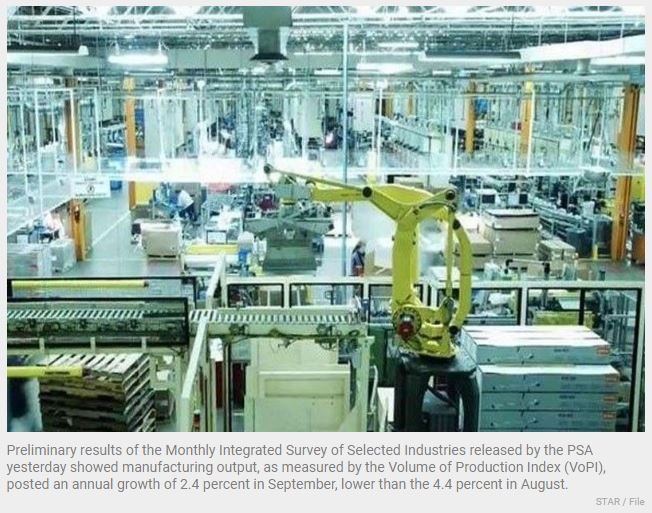Philippines: Factory output grows at slower pace in September
MANILA, Philippines — The country’s factory output grew at a slower pace in September from the previous month and year amid sustained high inflation.
Preliminary results of the Monthly Integrated Survey of Selected Industries released by the PSA yesterday showed manufacturing output, as measured by the Volume of Production Index (VoPI), posted an annual growth of 2.4 percent in September, lower than the 4.4 percent in August.
It was also way below the 124.3 percent expansion in VoPI in September last year.
The PSA said nine industry divisions posted annual declines in September, with the manufacture of electrical equipment registering the biggest drop of 54.7 percent.
Other industry groups with annual decreases were basic metals (34.2 percent), beverages (6.8 percent), coke and refined petroleum products (2.8 percent), rubber and plastic products (4.9 percent), furniture (11.5 percent), printing and reproduction of recorded media (6.5 percent), tobacco products (three percent) and non-metallic mineral products (0.3 percent).
Meanwhile, those which saw annual increases in September were computer, electronic and optical products; transport equipment; food products; machinery and equipment except electrical; chemical and chemical products; fabricated metal products, except machinery and equipment; wood, bamboo, cane, rattan articles and related products; paper and paper products; other manufacturing, and repair and installation of machinery and equipment; textiles; wearing apparel; basic pharmaceutical products and pharmaceutical preparations; and leather and related products, including footwear.
Michael Ricafort, chief economist at Rizal Commercial Banking Corp., attributed the slower growth in VoPI to higher inflation both locally and globally.
The country’s inflation rate accelerated to a near-14-year high of 7.7 percent in October from 6.9 percent in September.
Ricafort said elevated inflation or prices of inputs could have slowed down the growth in the manufacturing gauge “in view of the need to pay for more expensive oil or fuel, imported commodities, other imports, and other inputs (as these could have also reduced available funds for consumer spending and business spending, new investments or expansion projects, and for other manufacturing or production activities), as well as slower demand in reaction to higher prices (some form of demand destruction, in reaction to higher prices).”
He said higher interest rates that increased borrowing or financing costs for some manufacturers could have also affected the performance of the manufacturing sector.
The PSA said the Value of Production Index (VaPI) posted a 10-percent growth in September this year, also slower than the 11.8 percent in August and the 124.6 percent increase in September last year.
The PSA said 15 out of the 22 industry divisions contributed to the growth in VaPI in September.
These are computer, electronic and optical products; food products; transport equipment; chemical and chemical products; machinery and equipment except electrical; coke and refined petroleum products; fabricated metal products, except machinery and equipment; wood, bamboo, cane, rattan articles and related products; paper and paper products; other manufacturing and repair and installation of machinery and equipment; non-metallic mineral products; textiles; wearing apparel; basic pharmaceutical products and pharmaceutical preparations; and leather and related products, including footwear.
Those which registered declines in September are basic metals; electrical equipment; beverages; printing and reproduction of recorded media; furniture; rubber and plastic products; and tobacco products.
Average capacity utilization rate for the manufacturing sector increased slightly to 71.5 percent in September from 71.4 percent in August.
“There were 20 out of 22 industry divisions with more than 60 percent average capacity utilization rate, led by manufacture of wearing apparel (80.9 percent), manufacture of furniture (80.3 percent), and manufacture of computer, electronic, and optical products (80 percent),” PSA said.
More than a fifth or 22 percent of the responding establishments operated at full capacity or at 90 to 100 percent.
Meanwhile, 39.1 percent operated at 70 to 89 percent, while 38.9 percent operated below 70 percent capacity.
Source: https://www.philstar.com/business/2022/11/09/2222410/factory-output-grows-slower-pace-september


 Thailand
Thailand




